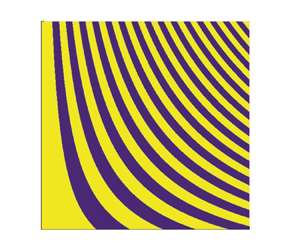Article contents
Effect of surfactants on the long-wave stability of two-layer oscillatory film flow
Published online by Cambridge University Press: 05 October 2021
Abstract

The stability of the two-layer film flow driven by an oscillatory plate under long-wave disturbances is studied. The influence of key factors, such as thickness ratio ( $n$), viscosity ratio (
$n$), viscosity ratio ( $m$), density ratio (
$m$), density ratio ( $r$), oscillatory frequency (
$r$), oscillatory frequency ( $\beta$) and insoluble surfactants on the stability behaviours is studied systematically. Four special Floquet patterns are identified, and the corresponding growth rates are obtained by solving the eigenvalue problem of the fourth-order matrix. A small viscosity ratio (
$\beta$) and insoluble surfactants on the stability behaviours is studied systematically. Four special Floquet patterns are identified, and the corresponding growth rates are obtained by solving the eigenvalue problem of the fourth-order matrix. A small viscosity ratio ( $m\le 1$) may stabilize the flow but it depends on the thickness ratio. If the viscosity ratio is not very small (
$m\le 1$) may stabilize the flow but it depends on the thickness ratio. If the viscosity ratio is not very small ( $m>0.1$), in the
$m>0.1$), in the  $(\beta ,n)$-plane, stable and unstable curved stripes appear alternately. In other words, under the circumstances, if the two-layer film flow is unstable, slightly adjusting the thickness of the upper film may make it stable. In particular, if the upper film is thin enough, even under high-frequency oscillation, the flow is always stable. The influence of density ratio is similar, i.e. there are curved stable and unstable stripes in the
$(\beta ,n)$-plane, stable and unstable curved stripes appear alternately. In other words, under the circumstances, if the two-layer film flow is unstable, slightly adjusting the thickness of the upper film may make it stable. In particular, if the upper film is thin enough, even under high-frequency oscillation, the flow is always stable. The influence of density ratio is similar, i.e. there are curved stable and unstable stripes in the  $(\beta ,r)$-planes. Surface surfactants generally stabilize the flow of the two-layer oscillatory membrane, while interfacial surfactants may stabilize or destabilize the flow but the effect is mild. It is also found that gravity can generally stabilize the flow because it narrows the bandwidth of unstable frequencies.
$(\beta ,r)$-planes. Surface surfactants generally stabilize the flow of the two-layer oscillatory membrane, while interfacial surfactants may stabilize or destabilize the flow but the effect is mild. It is also found that gravity can generally stabilize the flow because it narrows the bandwidth of unstable frequencies.
- Type
- JFM Papers
- Information
- Copyright
- © The Author(s), 2021. Published by Cambridge University Press
References
REFERENCES
- 1
- Cited by





